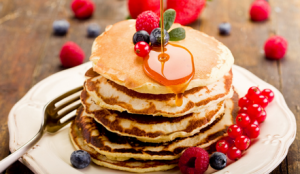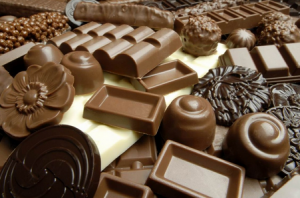Chocolate processing practices haven’t changed much from the time of the Maya; it is just that the equipment and processes have been refined. These processes can be divided into six major steps:
In the Cacao Field
Harvest and Fermentation
Cacao trees produce buds on a continuous basis—this can be year-round in subtropical areas, such as Central America or it can be tied to the rain cycle, as it is in Africa. Fluctuations in growth cycle and harvest can occur because of changes in climate conditions.
Harvesting the cacao pods is still done by hand, as the mature pods need to be identified and cut from the tree, without damaging flower buds, immature pods or the stem area from which the bud grows. For pictures of the different types of cacao and shapes of pods go to Hawaii Cacao.
The pods are carefully broken open to release the cacao beans, which are embedded in a moist, fibrous, white pulp. The beans and pulp are scooped out quickly and either heaped in a pile on mats or banana leaves and covered, or put into a bin or box with a lid.
Fermentation occurs when the pulp surrounding the cacao bean is converted into alcohol by the yeasts present in the air and the heat generated by the pile or box. The beans are mixed gently during this process to introduce oxygen into the pile or box, which turns the alcohol into lactic and acetic acid. Slits or holes in the box allow the resulting liquid with its alcohol content to slowly leak out of the pile of beans during the fermentation process, leaving just the beans.
Germination in the cacao bean is killed by the high temperatures produced during the fermentation process. The beans gather moisture from the environment and plump. Their flavor begins to change from mainly bitter to the beginnings of the complex flavor called chocolate.
The fermentation process can take up to eight days, depending on the species of cacao bean. Better fermentation results in better flavor and requires less roasting time to bring out that flavor.
Drying and Storage
The cocoa beans, as they are now called after fermentation, come out of this process with a high moisture content. In order to be shipped or stored, they must be dried.
The drying process differs, depending on the climate or size of the plantation. Cocoa beans can be dried out in the sun on trays or mats where the climate permits. Sun-drying usually happens in smaller plantations in drier environments. In tropical areas, where daily rainfall is the norm, the beans can be dried in sheds, as long as there is enough air circulating around the flats of beans. The use of wood fire to speed the drying process is disliked by bulk chocolate manufacturers and chocolatiers, as the process leaves the beans with a smoky taste.
Once the moisture percentage in the cocoa beans has reached 6 to 7 percent, they are sorted and bagged. The sorting process is very important because the cocoa beans are classified and sold in the industry by their size and quality. The bagged cocoa beans are then loaded on ships to be delivered to chocolate manufacturers.
In the Manufacturing Plant
Each chocolate manufacturer has a closely guarded “secret recipe” for each chocolate product that it produces. This secret begins with the type and quality of the cocoa beans used. I will use the symbol: § to indicate points in the process where the manufacturer may use their own secret formula.
Testing, Cleaning, and Roasting
When the selected § cocoa beans arrive at the manufacturing plant they go through a very extensive sampling and testing procedure. Sample cocoa beans are tested for size and defects, such as insects or mold, and then converted into chocolate liquor, which is evaluated for flavor and aroma by company tasters. Once the testing is complete and the shipment is accepted by the manufacturer, the beans are thoroughly cleaned to remove any foreign matter. The cocoa beans then go into the roaster for anywhere from § 10 to 35 minutes.
Cracking (or Fanning) and Grinding
While roasting, the shell of the cocoa bean separates from the bean kernel and is removed in the first step of the cracking or fanning process. The beans are cracked (not crushed) by being passed through serrated cones. The cracked beans are now called cocoa nibs.
As the shell is dry and lightweight, it can be winnowed from the cocoa nib. Winnowing is done by exposure to a current of air, so that the shells are blown free of the heavier nibs. The nibs contain approximately 53 percent cocoa butter, depending on the cacao species.
Grinding or Refining
The first grind of the beans is usually done in a milling or grinding machine such as a melangeur. The nibs are ground or crushed to liquefy the cocoa butter and produce what is now called chocolate liquor or chocolate liquid.
For the second refining process, most chocolate manufacturers use a roll refiner or ball mill, which has two functions: to further reduce the particle size of the cocoa mass (and any other ingredients, such as sugar or milk powder) and to distribute the cocoa butter evenly throughout the mass, coating all the particles.
The rolling process itself creates heat that melts and distributes the cocoa butter. As well as the flavor of the chocolate, manufacturers must decide on the § particle size for each of their chocolates. This is the first step to developing chocolate’s smooth and creamy mouth-feel.
Different percentages of § cocoa butter are removed or added to the chocolate liquor. Cocoa butter carries the flavor of the chocolate and produces a cooling effect on your tongue that you might notice when eating dark chocolate. Also, depending on the chocolate flavor desired, some or all of the following § ingredients are added: sugar, lecithin, milk or cream powder or milk crumb (used to produce a caramel-like taste in milk chocolate), and spices such as vanilla. The formula the chocolate manufacturer develops for combining specific ingredients with the chocolate liquor is what gives the chocolate its unique taste.
Conching
This process develops the flavor of the chocolate liquor, releasing some of the inherent bitterness and gives the resulting chocolate its smooth, melt-in-your-mouth quality. The conch machine has rollers or paddles that continuously knead the chocolate liquor and its ingredients over a § period of hours or days depending on the flavor and texture desired by the manufacturer.
Tempering and Forming Chocolate
For the last two steps in the chocolate process, the conched chocolate mass is tempered and molded into bulk bars or it may go into another production cycle to produce specialized retail products, such as coated-candy centers and molded items.
Pelajaran — bagaimana cokelat yang dibuat
Gambaran singkat bagaimana cokelat terbuat dari kacang untuk bar. Setiap langkah dalam proses penting untuk menarik rasa terbaik dari biji.
Praktek-praktek pengolahan cokelat tidak berubah banyak sejak Maya; bahwa peralatan dan proses telah disempurnakan. Proses ini dapat dibagi menjadi enam langkah-langkah utama:
Di bidang kakao
Panen dan fermentasi
Pohon kakao menghasilkan tunas secara terus–menerus-ini bisa menjadi sepanjang tahun di daerah subtropis, seperti Amerika Tengah atau dapat dikaitkan dengan siklus hujan, seperti di Afrika. Siklus fluktuasi dalam pertumbuhan dan panen dapat terjadi karena perubahan dalam kondisi iklim.
Pemanenan polong kakao masih dilakukan dengan tangan, polong dewasa perlu diidentifikasi dan dipotong dari pohon, tanpa merusak kuncup bunga, buah belum matang atau daerah batang yang kuncup tumbuh. Untuk gambar dari berbagai jenis kakao dan bentuk polong pergi ke Hawaii kakao.
Buah hati-hati yang rusak terbuka untuk melepaskan biji kakao, yang tertanam dalam pulp lembab, berserat, putih. Kacang dan pulp meraup dengan cepat dan baik menumpuk di tumpukan pada tikar atau pisang daun dan tertutup, atau dimasukkan ke dalam bin atau kotak dengan tutupnya.
Fermentasi terjadi ketika pulp sekitar biji kakao diubah menjadi alkohol oleh ragi yang ada di udara dan panas yang dihasilkan oleh tumpukan atau kotak. Kacang dicampur dengan lembut selama proses ini untuk memperkenalkan oksigen ke dalam tumpukan atau kotak, yang ternyata alkohol menjadi asam laktat dan asetat. Celah atau lubang di kotak memungkinkan yang dihasilkan cair dengan kadar alkohol perlahan-lahan bocor dari tumpukan kacang selama proses fermentasi dan hanya meninggalkan kacang.
Pengecambahan dalam biji kakao dibunuh oleh suhu tinggi dihasilkan selama proses fermentasi. Kacang mengumpulkan kelembaban dari lingkungan dan gemuk. Rasa mereka mulai mengubah dari terutama pahit ke awal dari rasa kompleks yang disebut cokelat.
Proses fermentasi dapat mengambil hingga delapan hari, tergantung pada jenis biji kakao. Fermentasi lebih baik menghasilkan rasa yang lebih baik dan membutuhkan waktu kurang memanggang untuk membawa keluar rasa yang.
Pengeringan dan penyimpanan
Biji kakao, sebagaimana mereka sekarang disebut sesudah proses fermentasi, keluar dari proses ini dengan kadar air tinggi. Untuk dikirim atau disimpan, mereka harus dikeringkan.
Proses pengeringan berbeda, tergantung pada iklim atau ukuran perkebunan. Biji kakao dapat menjadi kering di bawah sinar matahari pada nampan atau tikar mana iklim izin. Pengeringan matahari biasanya terjadi di kecil perkebunan di lingkungan yang kering. Di daerah tropis, dimana curah hujan harian adalah norma, kacang-kacangan dapat kering di gudang, asalkan ada cukup udara beredar di sekitar Flat kacang. Penggunaan kayu api untuk mempercepat proses pengeringan disukai oleh produsen massal cokelat dan chocolatiers, sebagai proses daun kacang dengan rasa berasap.
Setelah persentase kelembaban dalam biji kakao telah mencapai 6 untuk 7 persen, diurutkan dan dikantongi. Proses penyortiran ini sangat penting karena biji kakao diklasifikasikan dan dijual dalam industri oleh ukuran dan kualitas. Biji kakao kantong yang kemudian dimuat di kapal diserahkan kepada produsen coklat.
Di pabrik
Masing-masing produsen coklat memiliki dijaga “resep rahasia” untuk setiap produk cokelat yang dihasilkannya. Rahasia ini dimulai dengan jenis dan kualitas dari biji kakao yang digunakan. Saya akan menggunakan simbol: § untuk menunjukkan poin dalam proses dimana produsen dapat menggunakan rumus rahasia mereka sendiri.
Pengujian, membersihkan, dan memanggang
Ketika biji kakao dipilih § tiba di pabrik mereka pergi melalui sampling sangat luas dan prosedur pengujian. Biji kakao sampel diuji untuk ukuran dan Cacat, seperti serangga atau cetakan, dan kemudian dikonversi menjadi kakao liquor, yang dievaluasi untuk rasa dan aroma oleh perusahaan icip. Setelah pengujian selesai dan pengiriman yang diterima oleh produsen, kacang yang dibersihkan secara menyeluruh untuk menghapus masalah asing. Biji kakao kemudian pergi ke sangrai untuk di mana saja dari § 10–35 menit.
Retak (atau mengipasi) dan Grinding
Saat memanggang, tempurung dari biji kakao yang memisahkan dari kernel kacang dan dihapus pada langkah pertama retak atau mengipasi proses. Biji pecah-pecah (tidak hancur) oleh sedang melewati bergerigi kerucut. Kacang retak sekarang disebut biji kakao.
Seperti shell kering dan ringan, itu bisa ditampi dari nib kakao. Tampi dilakukan oleh paparan terhadap arus udara, sehingga kerang ditiup gratis biji lebih berat. Biji mengandung sekitar 53 persen mentega kakao, tergantung pada spesies kakao.

















